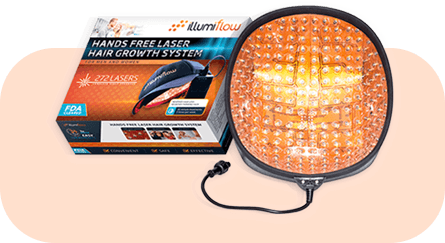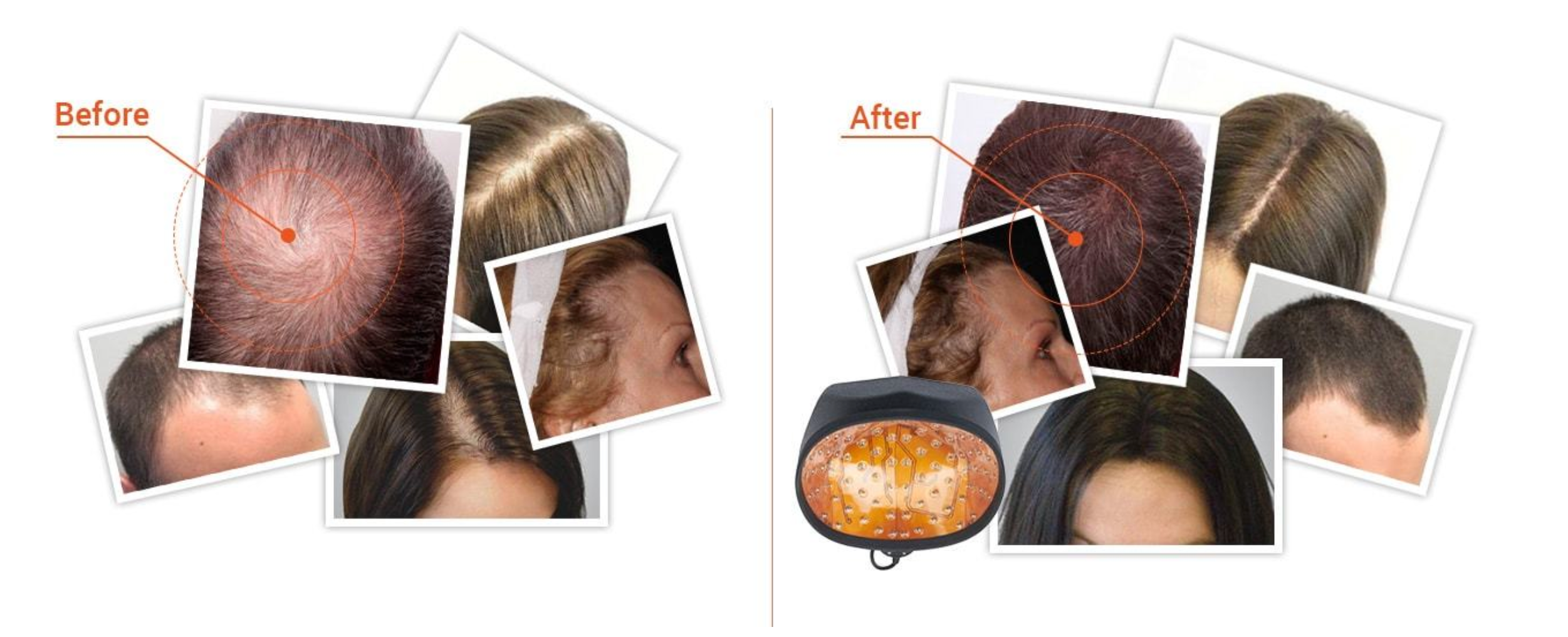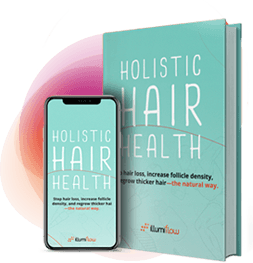Clinically Proven Tech, Cleared by the FDA
The illumiflow Laser Cap has been masterfully designed, from top to bottom, to regrow hair.
It works by stimulating your scalp with concentrated red light energy at very specific wavelengths calibrated to the perfect depth of penetration. Your cells are then boosted with new energy, promoting increased health overall, as well as new growth.
Maybe You Are a Bit Skeptical?
If so, don't worry I was too. Read on to uncover real proof about the scientifically-validated quality of this amazing technology.
Low Level Laser Therapy
The illumiflow Laser Cap uses Low Level Laser Therapy (LLLT) to regrow hair at a cellular level.
This therapy has been the subject of numerous clinical studies that have been verified by scientists at the highest levels.
LLLT has multiple uses.
It alleviates pain from injury and arthritis. Chronic pain has been effectively relieved using this groundbreaking therapy and it has also become popular with physicians for helping to heal damaged tissue.
Those with Carpal Tunnel Syndrome, Fibromyalgia, and Tendinitis have all benefited from LLLT.
Scientific Proof of Concept
Seeing the excellent results from LLLT in healing damaged tissue led researchers to study this technology for use in the area of hair regrowth.
A recent study (R) by scientists and physicians in the Department of Dermatology and Cutaneous Surgery at the "University of Miami Miller School of Medicine" found that LLLT is effective in treating multiple types of hair loss.
Male pattern baldness, female pattern baldness, and hair loss due to chemotherapy treatments have all seen incredible results as a result of using this technology.
Those who suffer from alopecia areata, an autoimmune disorder that causes hair loss, benefited from this treatment as well.
Not only did this study prove that LLLT promotes new hair growth, but it also determined that the treatment is safe with no known side effects.
Download the full study here
Proof, Proof, And More Proof
A joint study was conducted by the "Wellman Center for Photomedicine at Massachusetts General Hospital, the Department of Dermatology at Harvard Medical School and the Department of Dermatology, Venereology and Dermato-Oncology at Semmelweis University School of Medicine in Budapest."
This expansive study corroborated the findings from the University of Miami.
Using LLLT on multiple patients, the scientists involved in this study found that LLLT is a safe and effective treatment for hair loss.
The results show that stimulating hair follicles using these targeted lasers creates a shift in the life cycle of the hair follicle. In simple terms, the lasers cause hair cells to enter an active growth cycle.
Yet another study, published by the "National Institutes of Health", used 44 subjects who suffered from hair loss.
Half of these subjects used an LLLT source while the other half used a placebo.
Over the course of only four months, more than half of the subjects using the LLLT treatment saw an increase in hair growth. That was nearly five times as many as had natural hair regrowth while using a placebo device.
Likewise, over the course of four months, none of the subjects experienced side effects in any way, shape, or form.
Safe & Effective Hair Growth with illumiflow
Ongoing studies continually prove that LLLT is a safe method for restoring cells.
Scientists around the world have focused their efforts on blind studies to ensure these treatments in no way impair the health of users. Universally, researchers agree that there is no risk in using laser technology, just like the technology used in the Laser Cap, to stimulate hair growth.
Below, you’ll find that we have compiled additional scientifically-verified examples of recent clinical studies for your review.
We expect you’ll be as impressed as we are with the efficacy and true potential of this brilliant hair restoration technology.
FDA Approval of LLLT
New research confirms that Low-Level Laser Therapy (LLLT) can stimulate new hair growth in people suffering from hair loss.
The therapy is based on the principle of photo-biotherapy, a procedure where laser light reactivates protein synthesis. Clinical trials demonstrate that inactive hair follicles can be made to resume protein synthesis through the use of this treatment.
Biostimulation lasers (also known as cold lasers, laser acupuncture devices, or soft lasers) were cleared for marketing by the FDA in 2007, with consideration to both the safety of these devices and the therapeutic claims made by researchers and manufacturers that it can effectively treat androgenic hair loss in men.
Red Light & Cold Lasers
LLLT uses cold lasers, which produce a specific frequency of light on the red end of the spectrum. Many years of clinical study have shown that light falling between the 630nm and 670nm wavelengths has the ability to stimulate hair follicles to resume protein synthesis after they have stopped producing protein due to injury or as a result of natural aging processes.
Clinical research suggests that LLLT may have effects equal to or better than hair loss medications in both men and women, and researchers believe that the treatment may be especially useful for women whose medical options may be limited.
The illumiflow Laser Cap
A proven application of low-light laser therapy technology, the illumiflow Laser Cap is a safe and painless hair restoration device that utilizes the principles behind LLLT in a form that looks and feels like an ordinary ball cap.
It gives the user the ability to apply treatments comfortably.
Click Here to Learn More
Indications & Safety
LLLT devices and treatments can be used safely while taking other medications such as Rogaine and Propecia.
Hair transplant surgery is not considered a contraindication for use, either, as the LLLT will not interfere with hair transplants and has even been used to help support the post-surgery healing process of the scalp.
Sources
- Avci P., Gupta G.K., Clark J., Wikonkal N., and Hamblin M.R. Low-level laser (light) therapy (LLLT) for treatment of hair loss. Lasers Surg Med. 2014 Feb; 46(2):144-51.
- Gupta A.K., and Daigle D. The use of low-level light therapy in the treatment of androgenetic alopecia and female pattern hair loss. J Dermatolog Treat 2014; 25, 162-3.
A Double Blind Confirmation
Thanks to study after study successfully proving the efficacy of LLLT in the treatment of hair loss, many physicians across the country now believe that it is both safe and effective for regular use.
LLLT is now frequently being recommended to patients as an effective treatment for hair loss in a wide range of cases.
The treatment has been used and studied broadly for 30 years or more, and has gained the favor of many practicing dermatologists and other health care professionals who believe their patients have benefited from the use of LLLT devices and treatments.
Since the early 1990s, the treatment has been widely accepted for use in treating pain after an injury or surgery and for its ability to hasten the healing process.
A recent study published in the American Journal of Clinical Dermatology documents the use of LLLT devices on 272 men and women suffering from both male pattern baldness and female pattern hair loss.
The study was conducted in facilities located in numerous institutions across the United States. The researchers investigated the effects of LLLT on 188 women and 146 men.
Subjects were divided into two primary groups: a test group using a real LLLT device; and a control group, who were given a placebo treatment. "In these clinical trials, they found that subjects who were treated using a placebo, or a “sham” device, received no measurable benefit from the treatment. Those who were treated with a real LLLT device reported an overall improvement."
"The results of these trials were consistent across male and female subjects, as well as across age ranges." There was no measurable difference in the reporting trends of groups based on either age or gender. In addition to the difference in self-reporting between the control and test groups, the "researchers also noticed a marked change in the thickness of hair growth in the test group, compared to a noticeable lack of change resulting in the control group."
Click HERE to download the full study
One-Year Study on 100 Mend & Women
While there have been a number of studies on the effects of short-term use of Low-Light Laser Therapy (LLLT) on hair loss that demonstrate a positive effect on patients suffering from pattern hair loss and alopecia, until now few have delivered the results of long-term use.
But in 2016, a study was released that reported on the findings of research into a one-year term of use for LLLT in both men and women suffering from hair loss.
Study Protocols
The study was broken into two six-month clinical trials. They were referred to as the 6-Month Initial and the 6-Month Extension studies.
Double-blind and single-blind protocols were used with both placebo-controlled groups and study groups.
Metrics
Results were evaluated on the grounds of hair counts obtained from micrographs of a circular area 1-inch in diameter, patient self-assessments of the results, researcher assessments of the results, and independent assessments of the results.
The Results
Patient and investigator assessments of the results both yielded positive results for the test group over the results of the control group.
That is to say, "subjects who received a real treatment, rather than a placebo treatment, were positively assessed as having improved hair growth density based on their own visual assessment, the visual assessment of an investigator, and the visual assessment of an independent evaluator."
Hair counts obtained from micrograph samples also yielded satisfying results. "The test group achieved significant increases in hair density and hair growth for all 12 months of the study."
Conversely, the control group experienced a measurable decline in hair counts over the 12-month period of study.
Safety Data
Finally, an area of particular concern was the safety of long-term LLLT applications.
"After one year following the study, none of the responding subjects have reported or been diagnosed with any adverse effects from the treatment.
Their progress has been sustainable, and their scalps are considered to be in healthy condition."
Sources
- Arndt K.A., Noe I.M. et al.: Laser Therapy. Basic concepts and nomenclature. J. am. Acad. Dermatol. Dec. 1981, 5
- Dwyer R.M., Bass M.: Laser Applications. Vol. III Monte Ross Ed. Academic press, N.Y., 1977.
- Fine S., Klein E.: Interaction of laser radiation with biological system. Proceeding of the first Conference on Biologic effects of laser radiations. Fed. Proc., 24, 35, 1965.
- Mester E., Ludany G., Sellyei M., Szende B., Tota J.: The stimulating effect of power laser rays on biological systems. Laser Rev., 1, 3, 1968.









